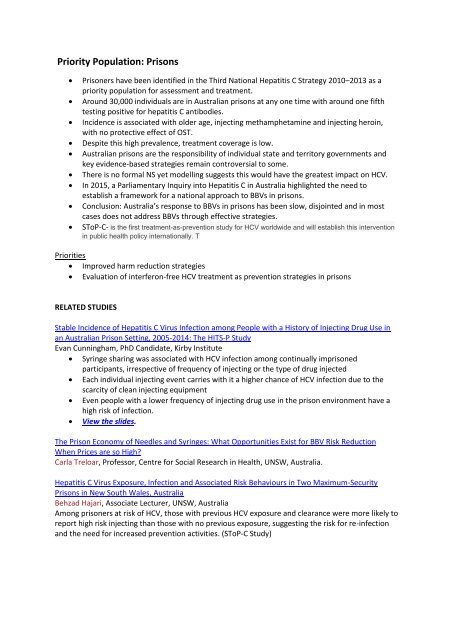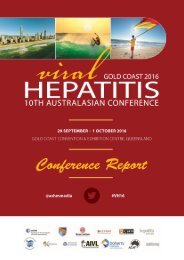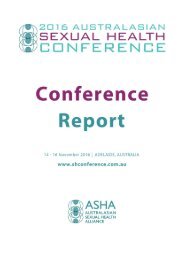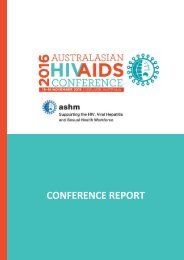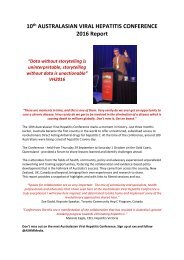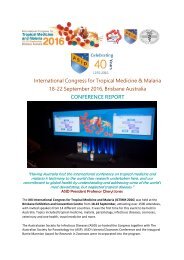You also want an ePaper? Increase the reach of your titles
YUMPU automatically turns print PDFs into web optimized ePapers that Google loves.
Priority Population: Prisons<br />
<br />
<br />
<br />
<br />
<br />
<br />
<br />
<br />
<br />
Prisoners have been identified in the Third National Hepatitis C Strategy 2010–2013 as a<br />
priority population for assessment and treatment.<br />
Around 30,000 individuals are in Australian prisons at any one time with around one fifth<br />
testing positive for hepatitis C antibodies.<br />
Incidence is associated with older age, injecting methamphetamine and injecting heroin,<br />
with no protective effect of OST.<br />
Despite this high prevalence, treatment coverage is low.<br />
Australian prisons are the responsibility of individual state and territory governments and<br />
key evidence-based strategies remain controversial to some.<br />
There is no formal NS yet modelling suggests this would have the greatest impact on HCV.<br />
In 2015, a Parliamentary Inquiry into Hepatitis C in Australia highlighted the need to<br />
establish a framework for a national approach to BBVs in prisons.<br />
Conclusion: Australia’s response to BBVs in prisons has been slow, disjointed and in most<br />
cases does not address BBVs through effective strategies.<br />
SToP-C- is the first treatment-as-prevention study for HCV worldwide and will establish this intervention<br />
in public health policy internationally. T<br />
Priorities<br />
Improved harm reduction strategies<br />
Evaluation of interferon-free HCV treatment as prevention strategies in prisons<br />
RELATED STUDIES<br />
Stable Incidence of Hepatitis C Virus Infection among People with a History of Injecting Drug Use in<br />
an Australian Prison Setting, 2005-2014: The HITS-P Study<br />
Evan Cunningham, PhD Candidate, Kirby Institute<br />
Syringe sharing was associated with HCV infection among continually imprisoned<br />
participants, irrespective of frequency of injecting or the type of drug injected<br />
Each individual injecting event carries with it a higher chance of HCV infection due to the<br />
scarcity of clean injecting equipment<br />
Even people with a lower frequency of injecting drug use in the prison environment have a<br />
high risk of infection.<br />
View the slides.<br />
The Prison Economy of Needles and Syringes: What Opportunities Exist for BBV Risk Reduction<br />
When Prices are so High?<br />
Carla Treloar, Professor, Centre for Social Research in Health, UNSW, Australia.<br />
Hepatitis C Virus Exposure, Infection and Associated Risk Behaviours in Two Maximum-Security<br />
Prisons in New South Wales, Australia<br />
Behzad Hajari, Associate Lecturer, UNSW, Australia<br />
Among prisoners at risk of HCV, those with previous HCV exposure and clearance were more likely to<br />
report high risk injecting than those with no previous exposure, suggesting the risk for re-infection<br />
and the need for increased prevention activities. (SToP-C Study)


